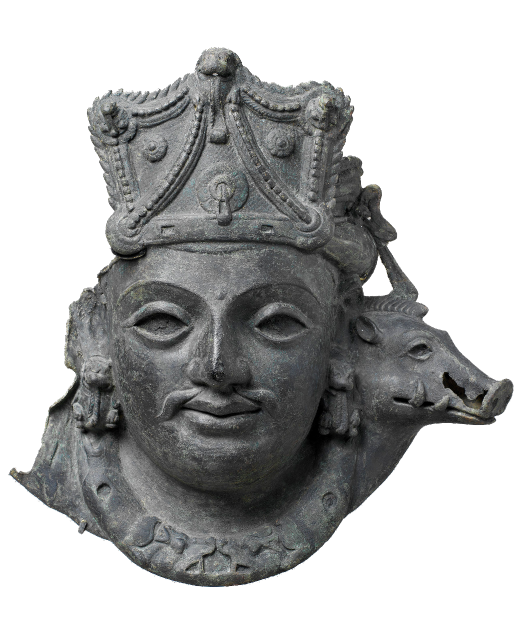PERSPECTIVES
From Rage to Rest: An Interview with Artist Sheelasha Rajbhandari
“I thought it was perfect that it would exist outside of Nepal,” says artist Sheelasha Rajbhandari about her Museum of Modern Art (MoMA) showcase in New York in September 2025. The “New Photography 2025: Lines of Belonging“ exhibition will feature her installation piece — Agony of the new bed – I will let a part of myself rest — which, for Rajbhandari, is a form of public protest. But it is also a deeply personal work; one that hits so close to home that she is relieved that she was able to express herself without “the pressure of immediate scrutiny.”
The installation has thirty miniature beds, painted in gold, their mattresses screen printed with black and white photos of women, many of them from weddings. The printed mattresses are overlaid with embroidered texts, scribbles, and patterns. Using both personal archives and textiles, Rajbhandari created this dollhouse-like artwork to explore the position of women in different times, landscapes, and cosmologies. Her aim was to mount an incisive critique of the patriarchal structures in Nepal, particularly the institution of marriage. She used embroidery — once forced upon women to please the families they marry into — as a form of catharsis. The slow, precise movements of the hand, employed in crafting domestic knick-knacks, are reimagined as tools to pick apart the same system that seek to confine women.
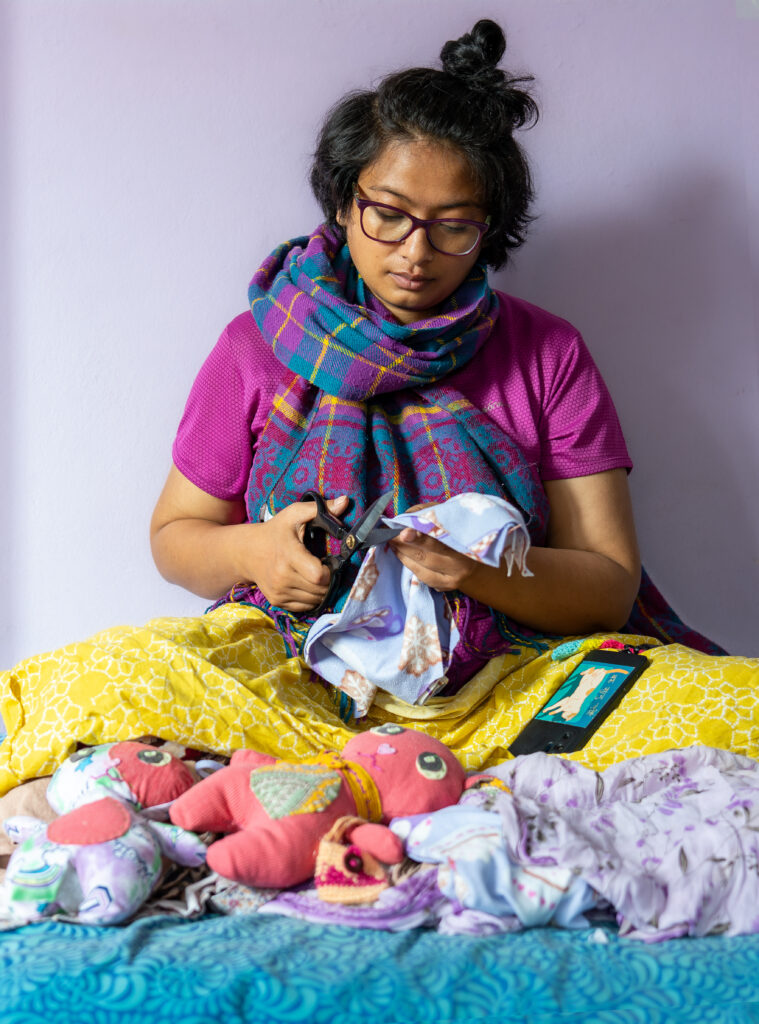
Beyond art making, and as the co-founder of ArTree Nepal and Kalā Kulo, Rajbhandari also seeks to question the neoliberal conception of time, where productivity and exhaustion are bound to cycles of extraction. Instead, she points to alternative possibilities of more reflective and collective practices and imagining different forms of kinship, certainly ones that extend beyond matrimony.
Shristi Shrestha: You made the first iteration of this work a while back. What were you responding to?
Sheelasha Rajbhandari: The first series was titled Agony of the new bed. I started this work in 2016, the same year I got married. Our own wedding was no more than a performance for us; a show we were staging for our family and the society. It wasn’t something either of us truly wanted. I was very critical of the institution of marriage. In fact, I used to have nightmares about it.
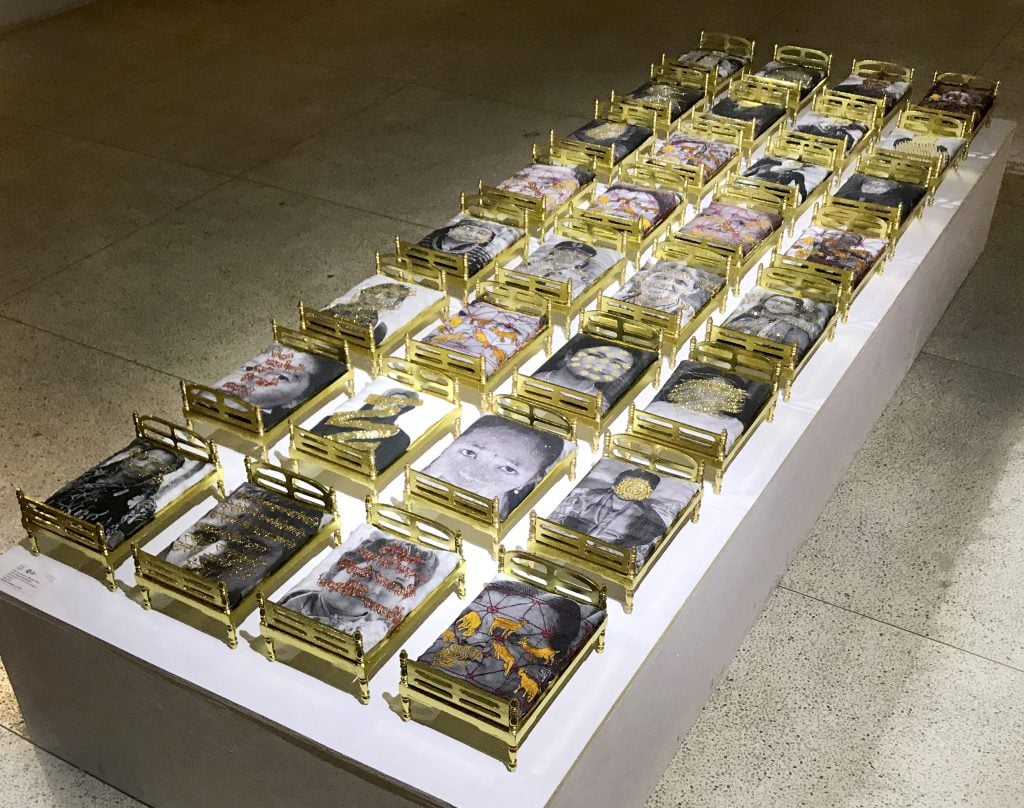
The work is a critique on the patriarchal system that marriage reinforces. As young girls and women, we are expected to be a certain way, dress a certain way, present ourselves a certain way. We are expected to get married; it’s not a choice. In Newa culture, girls are married to the bel fruit, during Ihi, and then to the sun, during Bara, at a very young age — even before getting married to a man. Your worth as a woman is always tied to a male counterpart. How do these expectations, embedded in our consciousness and our subconscious, shape our dreams and ambitions? Whose desires are being fulfilled? Who is being asked to keep sacrificing?
These questions tie into marriage, the migration that follows, the loss of identity, and the feeling of not belonging anywhere. The most dangerous thing is that this is normalised. Not just normalised, but celebrated! It is also this “celebration” that I wanted to critique. The use of gold, golden threads, and glass beads satirises the excesses of a wedding — of the glitter and festivity that surrounds an occasion where, in reality, someone’s identity is being erased.
Shrestha: Did you speak to other women in the process to understand their experiences of marriage?
Rajbhandari: The earlier version was a more collective process. I spoke to friends and relatives and realised that what I was feeling was not just a personal issue but a systematic one. Critiquing the system (as a collective) felt important. Ten years ago, when I first began, it was also difficult for me to speak openly about my own experiences. Times were also different then. I later reached a point where looking inward was not only possible, but essential.
Shrestha: The bed is a place of comfort for most. But in your work, it becomes a place of agony and violence. How does this contradiction play out?
Rajbhandari: In cultures where the practice of dowry is common, the bed is one of the things a woman brings to the husband’s house. As a result, they feel a sense of ownership over this object, and thus some sense of comfort, and belonging. Yet, even that bed is shared with their partner. What remains then that is solely hers? And I mean, literally, symbolically, metaphorically?
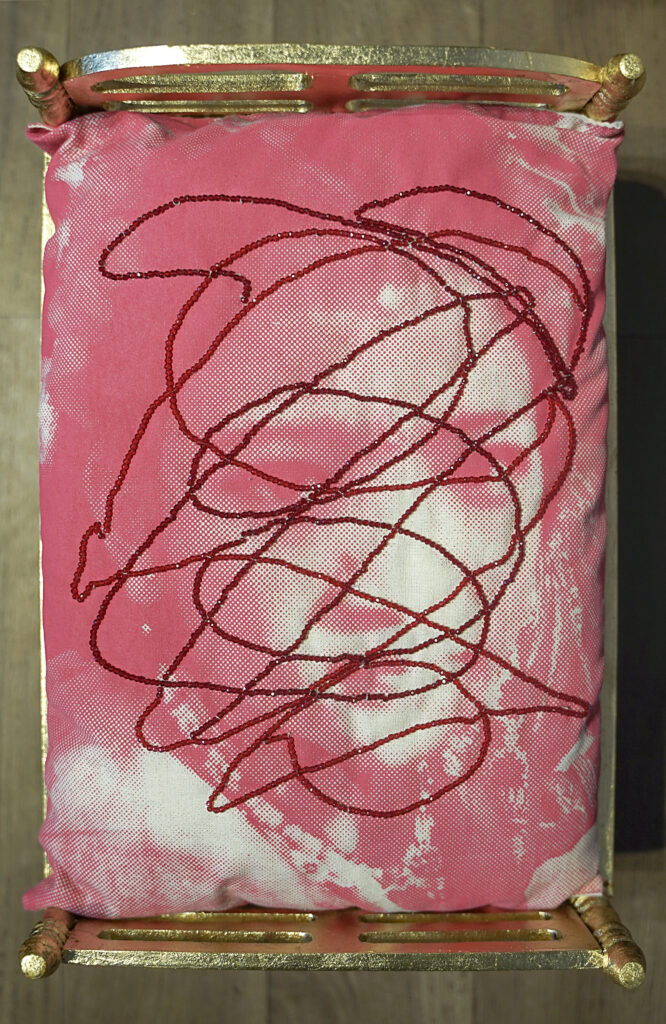
During my conversations, the issue of marital rape came up quite often. Sexual violence is not something we talk about, let alone sexual violence in marital relationships. Too often, marriage is used as an excuse to justify and allow that violence. Our imaginations of sexual violence are to a large extent shaped by the way it is depicted in Bollywood movies, where strangers force themselves on women. But sexual violence happens manipulatively and often in spaces that are deemed as safe. When I was young, I experienced sexual violence from a person who was supposed to protect me. When one has experienced violence of such kind, the bed, which we associate with comfort, becomes a very strange place.
Shrestha: You work with textiles and embroidery. How do these mediums function as a feminist and a political tool in your work?
Rajbhandari: I feel that a piece of textile carries so much history and meaning. In some of my works, I use pieces of my grandmother’s clothing, which already come with histories of their own. For women, domestic spaces are deeply charged spaces, and textiles, often passed down from one generation to another, become equally charged, both emotionally and politically. They hold memories, but also reflect the limited spaces where women have been allowed to express themselves or pass on their emotions.

When I was young, I often saw my grandmother, my aunt, and my mother embroidering and sewing all kinds of things. Some of them actually enjoyed it — the pleasure of making something with their own hands — but there was also the pressure to do it well, especially to impress their in-laws. As a woman, you were expected to learn these skills: knitting, sewing, caring for the house. It was very conflicting; even if you liked it, you couldn’t fully embrace it, because it wasn’t for you. It was always for others. Something so close to you, one of the few acts of self-expression, still didn’t belong to you.
When I started experimenting with embroidery, I found it to be meditative. It allowed me to reclaim that space; not out of pressure or expectation, but for my own pleasure. In fact, I often create a lot of embroidery that I never exhibit; it exists just for me. This process is very personal and a way for me to release my emotions. It’s like vomiting; something that had to come out of my body.
For me, reclaiming pleasure, instead of constantly performing for others, becomes a feminist act.
Shrestha: How has your work and your approach changed over the years?
Rajbhandari: I definitely started out with anger and frustration. The only way I could let it out then was through making art. Through my conversations with other women, I slowly began to understand what triggered me — both on a personal as well as on a systemic level. It required a lot of breakdowns and healing to get to the point where I am now. It feels like the work is now in its final stage. After many years of anger and rebellion, I am at a point where the part of me that felt that anger and anxiety can now rest. Hence the addition to the title too – “I will let a part of myself rest.” Initially, I had titled it — “I will rest in peace,” but that sounded rather dark.
This body of work is such an important marker in my life — to have this work come out of my head and body; to be able to do what I wasn’t able to do ten years ago. In the initial years, there was a lot of frustration in my inability to express what I was feeling. Now it feels like I’ve come to peace with the things that bothered me. The embroidered text in one of the mattresses reads “Can I continue fighting this system? The people I love? Myself?” I reached a point where I was tired of fighting the people I love. It’s often easier to fight others but when the struggle involves the people you care about, it becomes far more complicated. At some point, I found myself wondering, “How long can I continue to fight the battle, especially with the people I love. I began to feel like I was fighting myself.”
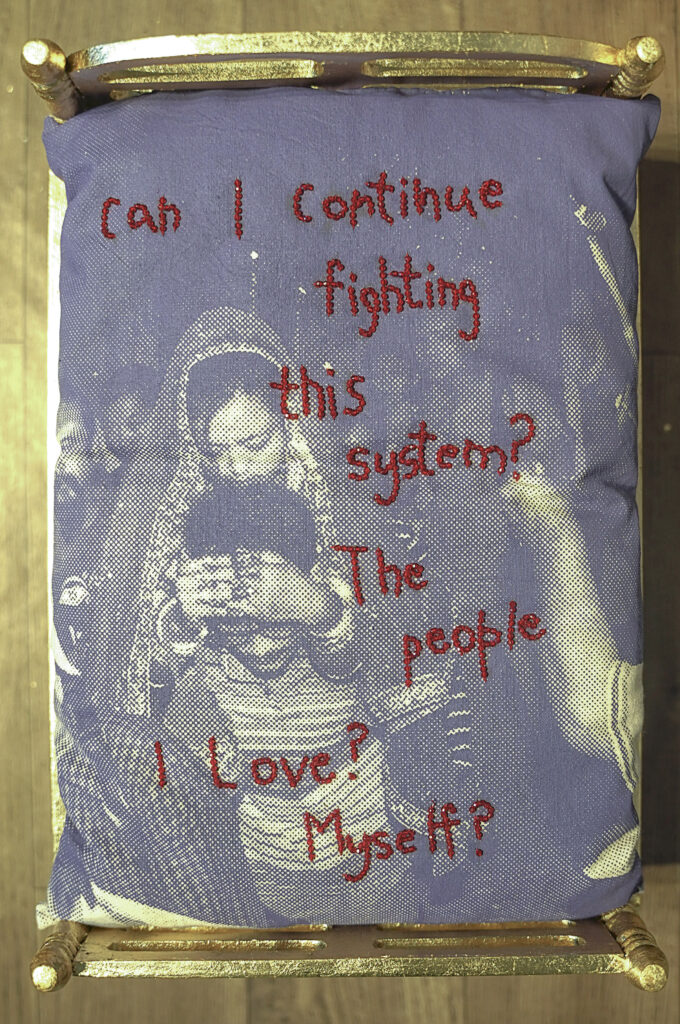
There’s another text that reads, “I can now grieve for the agony I/we endured.” The agony is not mine, alone. My grandmother used to tell me about how she really wanted to study, but could not continue her studies after getting married. After her marriage, she lost her childhood friends. Her brother is still close to his childhood friends. She had to move to another house and adopt a different identity. Yet even then, she was made to feel like she was never good enough.
In my mother’s case, she had children early and couldn’t do a lot of things she wanted to. She still carries that regret of marrying and having kids too soon.
And so I carry not just my trauma, but theirs too. But it was time that I allowed myself to feel and to grieve. And to allow a part of myself to rest.
Shrestha: How do you feel about showing your work at MoMA, where the majority of the audience will be away from the context you’re working in?
Rajbhandari: Honestly, I’m relieved. It almost feels safer to show the work outside of Nepal. It would be difficult for me to show it here. It worked out because I was anyway making this body of work and so when they approached me, I thought it was perfect that it would exist outside of Nepal. I was able to express myself fully, without the pressure of immediate scrutiny. I’m already involved in several other projects with the intention of building the art ecosystem in Nepal. So, it’s a relief not to carry that additional burden of having to explain myself here.
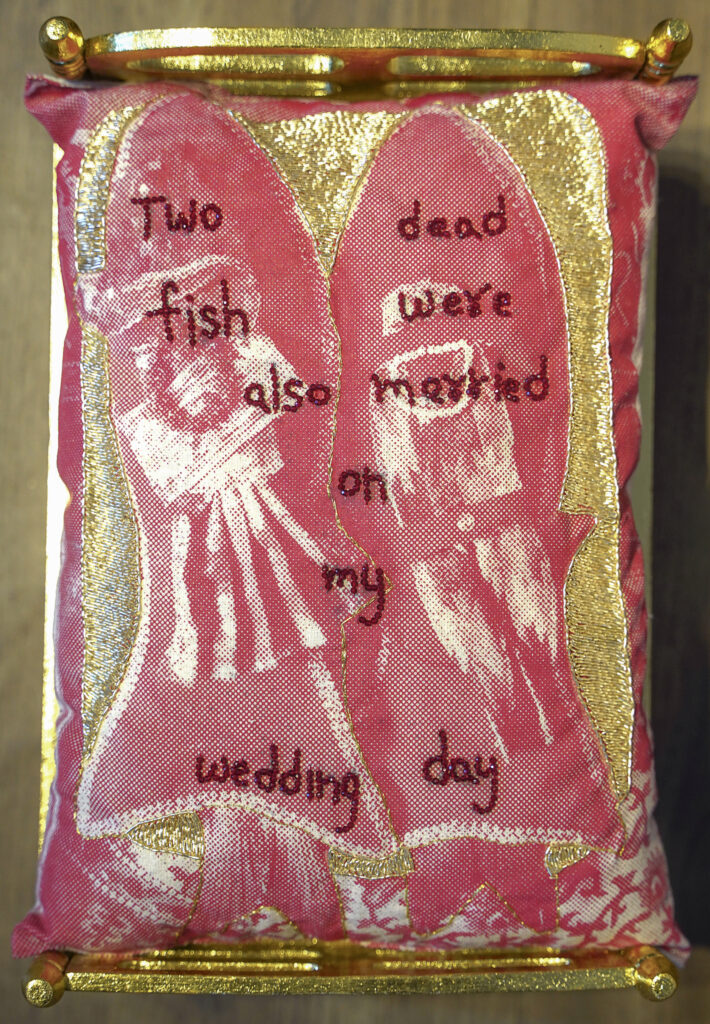
Shrestha: Could you elaborate on the art ecosystem you’re referring to?
Rajbhandari: We formed ArTree Nepal as a collective of five artists from different indigenous communities. After the People’s War, around 2010, during the peace process and the federalism movement, we came together and began to ask questions like: What does it really mean to be an indigenous artist? Is it enough to just carry that identity, or do we also have political responsibilities? What would indigenous aesthetics look like? How do we avoid exoticising ourselves? How can we use art to build discourse?
From the beginning, we have been self-organising our projects. We worked closely with community leaders and activists. A lot of our work was behind the scenes — making banners for protests, supporting movements — things we still do voluntarily today. In many ways, self-organising was necessary because there simply wasn’t an existing system. We couldn’t just be artists in that political climate; we had to create the structures that would allow us to keep working.
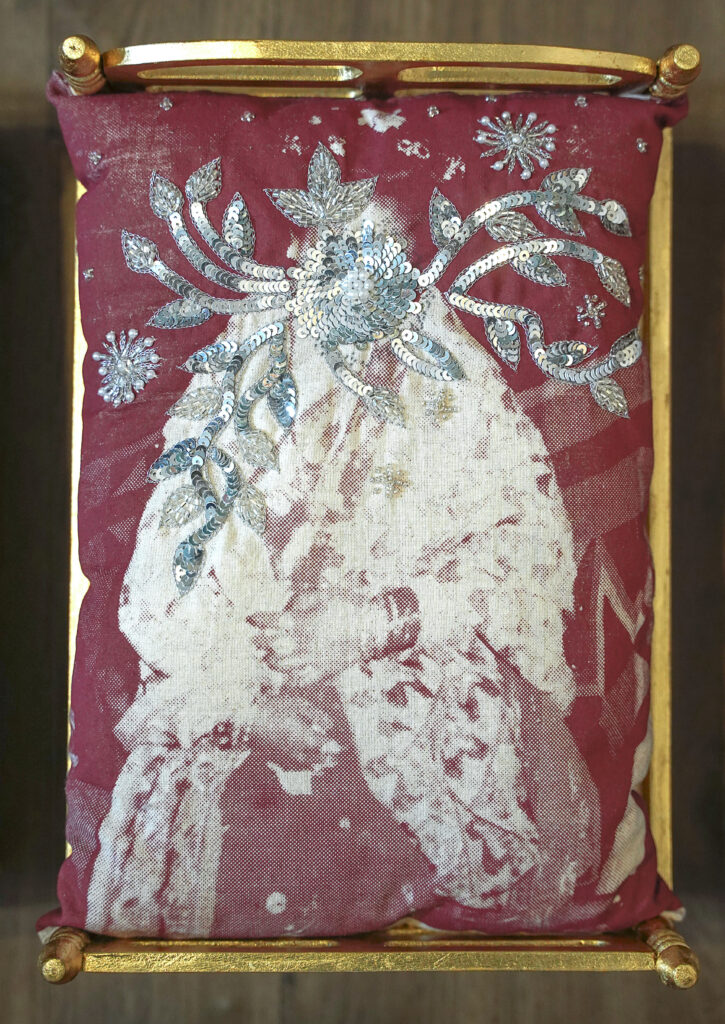
Over time, that self-organisation evolved in an artistic direction too. We began curating our own exhibitions, and eventually took part in larger showcases, like at the Kathmandu Triennale, the Nepal Pavilion at the Venice Biennale, Jogja Biennale, Colomboscope, SAVVY Contemporary, and the Asia Pacific Triennale. We’ve carried forward everything we built over the past decade, and that’s also why the artists we work with aren’t always those who are formally trained in art.
Then in 2019, we started Kalā Kulo. The idea was to create a more organised resource-sharing platform, including archiving. Some of us had already been doing this work individually, so it felt right to bring our efforts together. When COVID hit, we were suddenly faced with the fear of losing entire generations of knowledge, especially with the passing of many older people. That urgency pushed us into frantically digitising and archiving modernist artists’ works.
At the same time, we were very critical of archiving methodologies themselves. The central question for us was: Whose knowledge gets preserved, and how? We were documenting practices outside the mainstream, including art by Dalit artists from Jumla, Mithila art, and Tharu tattoo traditions. We did this together with the community. We recognised that many colonial methods of research and archiving don’t do justice to such practices, and we didn’t want to reproduce those frameworks. We didn’t have all the answers, but we wanted to at least create a space for questioning, for more nuanced conversations about visual art, anthropology, material practices, and embodied knowledge, which cannot always be captured. Whether through ArTree or Kalā Kulo, the work has always been about more than art — it’s about building an ecosystem and making space for emotions, critical thinking, process, but also strengthening our skills.
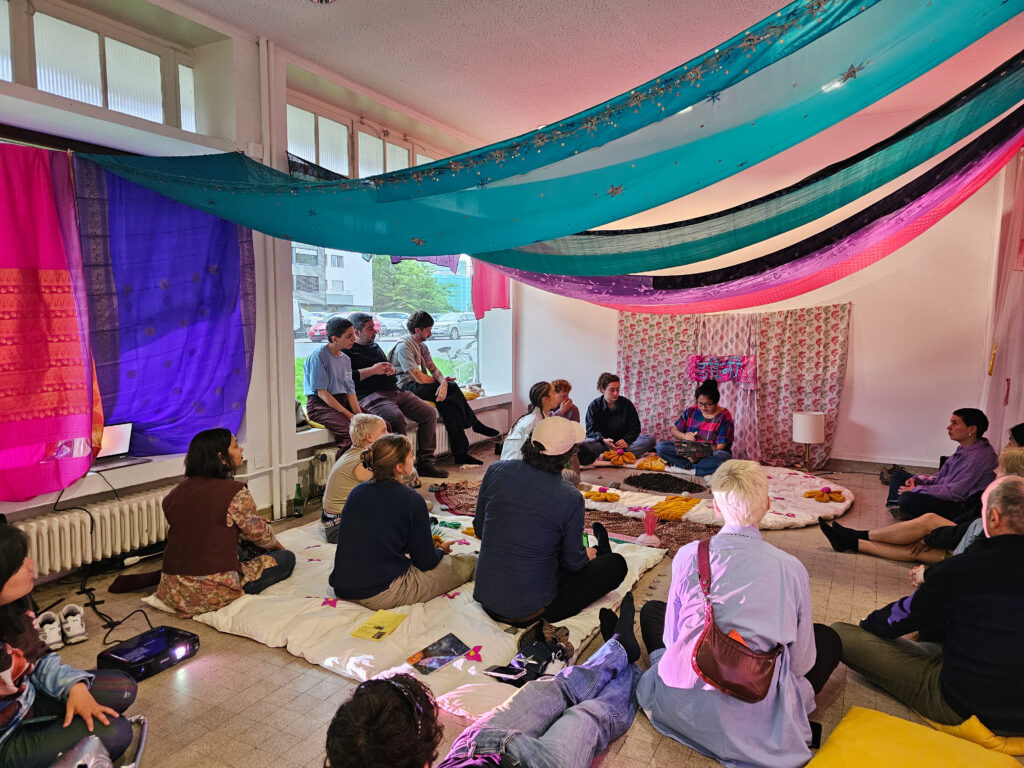
Shrestha: What are the ways in which the ideas of decolonising art and feminist practices manifest in your work?
Rajbhandari: I strongly believe in praxis. At ArTree, we’ve tried to work in an egalitarian way — not perfectly, but always with that intention. For us, that in itself is a decolonial practice. It’s not just about producing theory or standing on a stage giving speeches; it’s about bringing our own Indigenous values of sharing, caring, and coexisting into how we actually work together. That interconnected care is the reason we’ve survived as a collective until now.
There’s a difference between aesthetics and praxis. Often people make work that looks feminist on the surface, but when something happens, they remain neutral or silent. During the #MeToo movement, for example, I was struck by how many artists who positioned themselves as feminist chose not to speak up. For me, feminist or decolonial practice isn’t just about the artwork or the language we use, but about taking a stance, embodying those values in our everyday decisions and relationships.
Shristi Shrestha is a Kathmandu-based artist and curator exploring place, memory, and nostalgia. She values creating spaces for encounters between artists and communities, especially young audiences and women.
